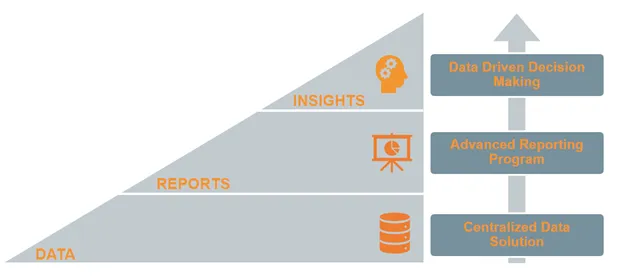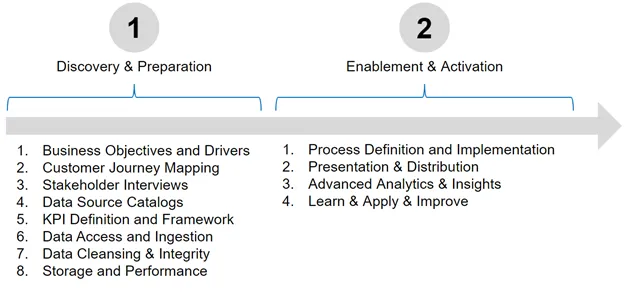Reporting and the Journey to Advanced Analytics

As we are approaching the year-end, digital analysts are facing a dreaded deliverable, the year-end performance reporting.
This can take many shapes, may it be an overall digital performance status, specific campaign rollup results, or a complex performance analysis, including insights and recommendations to apply over the next fiscal year. More on the business side of performance reporting here.
Before we offer advice on spending digital and/or media budgets to our data driven decision makers, a vital question needs to be asked: “am I equipped to do so?”. Setting the right expectations is something all analysts should do with the internal stakeholders, to avoid setting themselves up for failure.
Where are you positioned on a virtual maturity scale? Are you at a…
- Basic Level – reporting on basic web analytics stats such as sessions page views and time on site
- Intermediate Level – you have multiple sources and multiple reports on email campaigns, CRM database and web analytics
- Advanced Level – implemented a robust reporting program that involves a 360 degree view of the customer, sales attribution and predictive modelling
Regardless of where the organization is at, and where you find yourself within the journey to advanced analytics, a planned, methodical and, very important, scalable approach needs to be defined to establish, grow and activate a successful reporting program.
Crawl Before Running would be the first thing on the analyst’s mind. The goal is to evolve reporting & analysis from basic campaign reporting and ad-hoc requests to a more comprehensive view of the user journey, through a well-defined process involving interconnected and interdependent components. There are no actionable insights and recommendations without reports, there are no reports without data, there is no (usable) data without a proper deployment of data collection tools.

Planning is key to a robust reporting program as part of the journey to become a data driven decision making organization. Divided into two main phases, the below visualizes an approach to defining such a plan, breaking it down into its components.
Journey to Advanced Analytics:

Let’s have a look at the different components and what they mean for the analyst and the organization.
1. Discovery and Preparation
1.1. Business Objectives and Drivers
We seek a thorough understanding of the business priorities being supported by this initiative along with operational or strategic goals against which we should align or measure outcomes.
1.2. Customer Journey Mapping
A strategic approach to pinpointing the touchpoints throughout the customer’s path to conversion, may it be a purchase, subscription or content consumption. This ensures alignment between the multiple stakeholders on where, when and what needs to be monitored for actionable and insightful performance measurement.
1.3. Stakeholder Interviews
Identification and discussion with each business area leader that will carry a stake in our outcomes. Ensuring we are working toward the goals of all stakeholders is critical in ensuring a project of this nature receives the support and adoption it will demand.
1.4. Data System Catalogs
Technical discovery of the entire ecosystem of data sources and business systems included within this project. The cataloguing process will involve detailed research into the schema and relationship of these sources and initial data model planning.
1.5. KPI Definition and Framework
Based on the previous steps, the measurement plan is defined in alignment with the business goals and strategic objectives. Typically, this is the milestone where stakeholders provide feedback and buy-in prior to proceeding with the next steps.
1.6. Data Access and Ingestion
Further to the catalogs, a detailed understanding of how access to, and ongoing delivery of each data source will be accommodated. Connection tactics, limitations or other technical considerations will be identified and documented.
1.7. Data Cleansing & Integrity
Gain an understanding of the depth, complexity and potential risks or issues that might arise during the data preparation phase. Identification of gaps in data types or relational properties against our business drivers are key.
1.8. Storage and Performance
Assessments and planning for the scale, growth and performance of the Digital Intelligence environment. This topic focuses us in on the potential need for middleware or data lake technologies subject to the volume of information within the catalog, the rate at which we predict it will grow and the lookback window required for analysis by the business users.
2. Enablement & Activation
2.1. Process Definition and Implementation
Establish and align on ETL processes, tools and connections needed to transform the raw data into meaningful visualizations for the end users.
2.2. Presentation & Distribution
Reflecting on the stakeholder interviews, we can plan for the scope of the dashboard and visualization deliverables required. Number of users, frequency of access and preferences for automated report cards versus on-demand interactive dashboards all factor into the delivery of the final solution.
2.3. Advanced Analytics & Insights
As Insights and Analysis are never truly things that are ‘done’, it is important to align on the depths, nature and complexity of the analysis expected as a part of this initiative. Beyond supporting the stated business objectives, there are many ways in which advanced analytics can uncover new and exciting opportunities to drive business outcomes for the organization.
2.4. Learn & Apply & Improve
Identifying the required tactics and the specific role we will play in converting insights into actionable outcomes. Arguably the most critical aspect of the entire Advanced Analytics exercise is operationalizing change in the various areas of the organization in line with the evidence or hypotheses derived from the data.
Looking at the above, the imbalance between the two phases is obvious. Phase one, Discovery & Preparation is usually the one that requires more resources and time. A robust first phase ensures a solid foundation for the organization’s journey to advanced analytics and data driven decision making.
